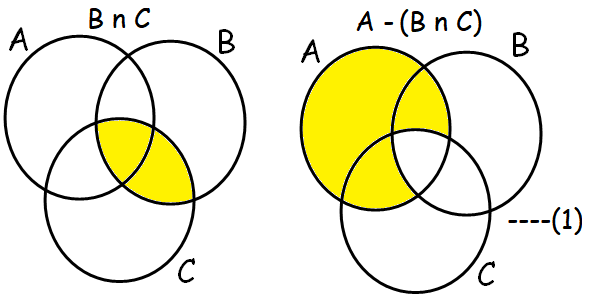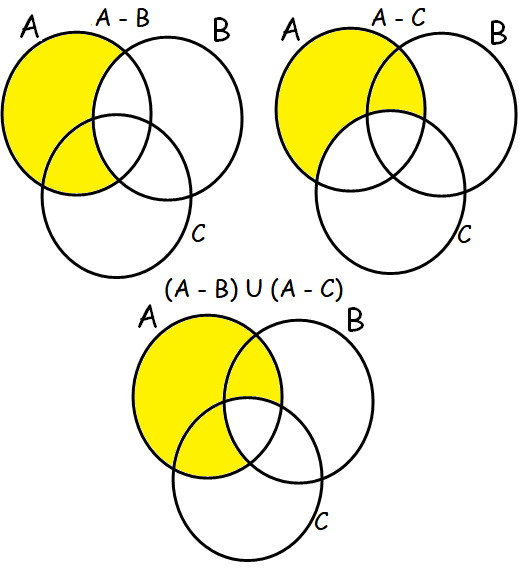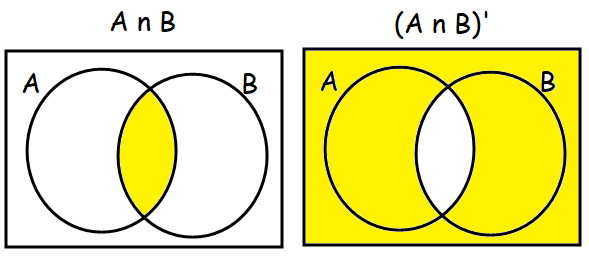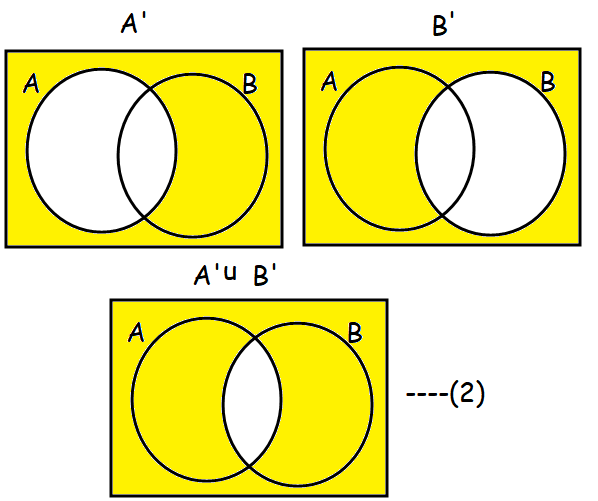VERIFYING DEMORGAN'S LAWS
Question 1 :
If A = {–2, 0, 1, 3, 5}, B = {–1, 0, 2, 5, 6} and C = {–1, 2, 5, 6, 7}, then show that A − (B U C) = (A − B) n (A − C)
Solution :
(B U C) = {-1, 0, 2, 5, 6, 7}
A − (B U C) = {-2, 1, 3} ----(1)
(A − B) = {-2, 1, 3}
(A − C) = {-2, 0, 1, 3}
(A − B) n (A − C) = {-2, 1, 3} ----(2)
(1) = (2)
Hence proved.
Question 2 :
If A = {y : y = (a + 1)/2, a ∈ W and a ≤ 5}, B = {y : y = (2n - 1)/2, n ∈ W and n < 5} and C = {-1, -1/2,1, 3/2, 2}, then show that A - (BUC) = (A - B) n (A - C)
Solution :
A = {y : y = (a + 1)/2, a ∈ W and a ≤ 5}
A = {1/2, 3/2, 2, 5/2, 3}
B = {y : y = (2n - 1)/2, n ∈ W and n < 5}
B = {-1/2, 1/2, 3/2, 5/2, 7/2}
C = {-1, -1/2, 1, 3/2, 2}
A - (BUC) = (A - B) n (A - C)
B U C = {-1/2, -1, 1/2, 1, 3/2, 2, 5/2, 7/2}
A - (BU C) = {3} -----(1)
(A - B) = {2, 3}
(A - C) = {1/2, 5/2, 3}
(A - B) n (A - C) = {3} -----(2)
(1) = (2)
Hence proved.
Question 3 :
Verify A − (B n C) = (A − B) U (A − C) using Venn diagrams.
Solution :


Question 4 :
If U = {4, 7, 8, 10, 11, 12, 15, 16}, A = {7, 8, 11, 12} and B = {4, 8, 12, 15}, then verify De Morgan’s Laws for complementation.
Solution :
De morgan's laws for complementation :
(i) (A U B)' = A' n B'
(ii) (A n B)' = A' U B'
A = {7, 8, 11, 12} and B = {4, 8, 12, 15},
U = {4, 7, 8, 10, 11, 12, 15, 16}
(i)
(A U B) = {4, 7, 8, 11, 12, 15}
(A U B)' = {10, 16} ----(1)
A' = {4, 10, 15, 16}
B' = {7, 10, 11, 16}
A' n B' = {10, 16} ----(2)
Hence proved.
(ii)
(A n B) = {8, 12}
(A n B)' = {4, 7, 10, 11, 15, 16} ----(1)
A' = {4, 10, 15, 16}
B' = {7, 10, 11, 16}
A' U B' = {4, 7, 10, 11, 15, 16} ----(2)
Hence proved.
Question 5 :
Verify (A n B)' = A' U B' using Venn diagrams.
Solution :


Kindly mail your feedback to v4formath@gmail.com
We always appreciate your feedback.
©All rights reserved. onlinemath4all.com
Recent Articles
-
AP Calculus BC Problems with Solutions
Apr 26, 25 05:49 AM
AP Calculus BC Problems with Solutions -
Digital SAT Math Problems and Solutions (Part - 150)
Apr 25, 25 11:46 AM
Digital SAT Math Problems and Solutions (Part - 150) -
AP Calculus AB Problems with Solutions (Part - 19)
Apr 24, 25 11:10 PM
AP Calculus AB Problems with Solutions (Part - 19)